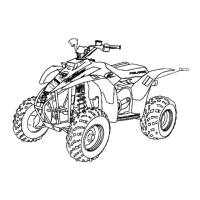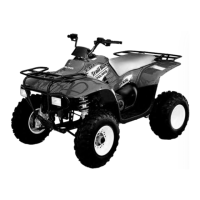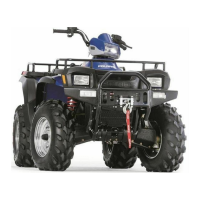11.24
REAR SUSPENSION
rebuilding are also available. Monotube shocks 9917736,
Remote Reservoir 9917737.
RYDE FX MONO-TUBE SHOCK
DISASSEMBLY
Procedures for the proper disassembly and assembly of
RydeFX gas charged IFP and emulsion mono-tube shock
absorbers.
1. Remove the shock(s) from the vehicle.
2. Before unscrewing pre-load springs, measure the
compressed length of the installed spring and mark
position for reinstallation.
3. If the shock incorporates a spring, remove the spring and
all collateral retainers.
4. Wash the shock body in parts cleaner; then dry with
compressed air to remove sand and dirt.
5. Remove bearing, sleeve and/or bushings from lower shock
mount eyelet. Secure the lower mount of the shock in a
vise. The use of soft jaws is recommend to prevent damage
or marks to the shock.
6. Remove the small button head screw from the pressure
valve assembly.
7. Depressurize the shock.
8. Internal Floating Piston Shocks, using a slotted
screwdriver, loosen the pressure valve assembly counter-
clockwise two full revolutions allowing the gas pressure to
fully escape past the pressure valve assembly O-ring.
9. Emulsion Shocks: With the shock inverted and the piston
rod fully extended, secure the lower mount of the shock in
a vise. Allow a couple of minutes for the gas pressure to
separate from the oil and rise to the top. Using a rag as a
shield to prevent spraying gas and oil; place rag over top
the pressure valve assembly and slowly loosen the valve
assembly with slotted screw driver three full revolutions,
allowing all the gas pressure to escape past the pressure
valve assembly O-ring.
10. Allow all the gas pressure to escape before proceeding
with the removal of the pressure valve assembly.
Pressurized gas and shock oil could eject the valve
assembly from the cylinder resulting in bodily injury.
11. Using a slotted screwdriver, remove the pressure valve
assembly from the lower end mount. Account for an O-
ring.
12. Using an adjustable face spanner (PN PS45262), fully
CAUTION
EXTREME CAUTION SHOULD BE OBSERVED WHILE HANDLING
AND WORKING WITH HIGH PRESSURE SERVICE EQUIPMENT.
W
EAR A FACE SHIELD, SAFETY GLASSES, AND EAR PROTEC-
TION DURING SERVICE OF THESE SHOCKS. CARE SHOULD BE
OBSERVED WHILE HANDLING THE INFLATER NEEDLE AND
PRESSURE GAUGES. MAINTAIN YOUR EQUIPMENT AND KEEP
IT IN GOOD WORKING CONDITION. IF INJURY SHOULD OCCUR,
CONSULT A PHYSICIAN IMMEDIATELY. EXTREME CLEANLI-
NESS IS OF UTMOST IMPORTANCE DURING ALL DISASSEMBLY
AND REASSEMBLY OPERATIONS TO PREVENT ANY DIRT OR
FOREIGN PARTICLES FROM GETTING INTO THE SHOCKS.
K
EEP THE PARTS IN ORDER AS THEY ARE DISASSEMBLED.
N
OTE THE DIRECTION AND POSITION OF ALL INTERNAL
PARTS FOR REASSEMBLY.
CAUTION
BEFORE SERVICING A GAS SHOCK IT IS IMPORTANT THAT
ALL THE GAS PRESSURE BE DISCHARGED FROM THE UNIT.
R
EFER TO THE INSTRUCTIONS LISTED BELOW FOR THE
PROPER PROCEDURE OF DISCHARGING THE GAS PRES-
SURE FROM A SHOCK. PROTECTIVE EYE WEAR SHOULD BE
WORN TO AVOID RISK OF INJURY WHILE SERVICING RY-
DEFX GAS CHARGED MONO-TUBE SHOCKS.
CAUTION
WHEN REMOVING THE SPRING FROM A SHOCK THAT UTILIZ-
ES A FIXED LOWER RETAINER; THE USE OF A PROPER
SPRING COMPRESSOR SHOULD BE USED TO AVOID RISK OF
BODILY INJURY.
WARNING
WHEN USING COMPRESSED AIR TO DRY COMPONENTS,
PROTECTIVE EYE WEAR SHOULD BE WORN TO AVOID RISK
OF INJURY.
CAUTION
IT IS IMPORTANT THAT THE GAS SHOCK BE RETAINED IN
THE VISE BY THE LOWER MOUNT. ANY OTHER METHOD
OF SECURING THE CHOCK BODY DURING THESE PRO-
CEDURES MAY DEFORM THE SHOCK BODY CYLINDER.
WARNING
NITROGEN GAS IS UNDER EXTREME PRESSURE. USE
CAUTION WHEN RELEASING NITROGEN GAS FROM
SHOCK. PROTECTIVE EYE WEAR SHOULD BE WORN TO
AVOID RISK OF INJURY.
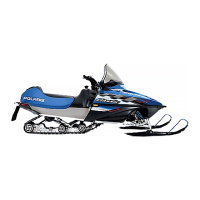
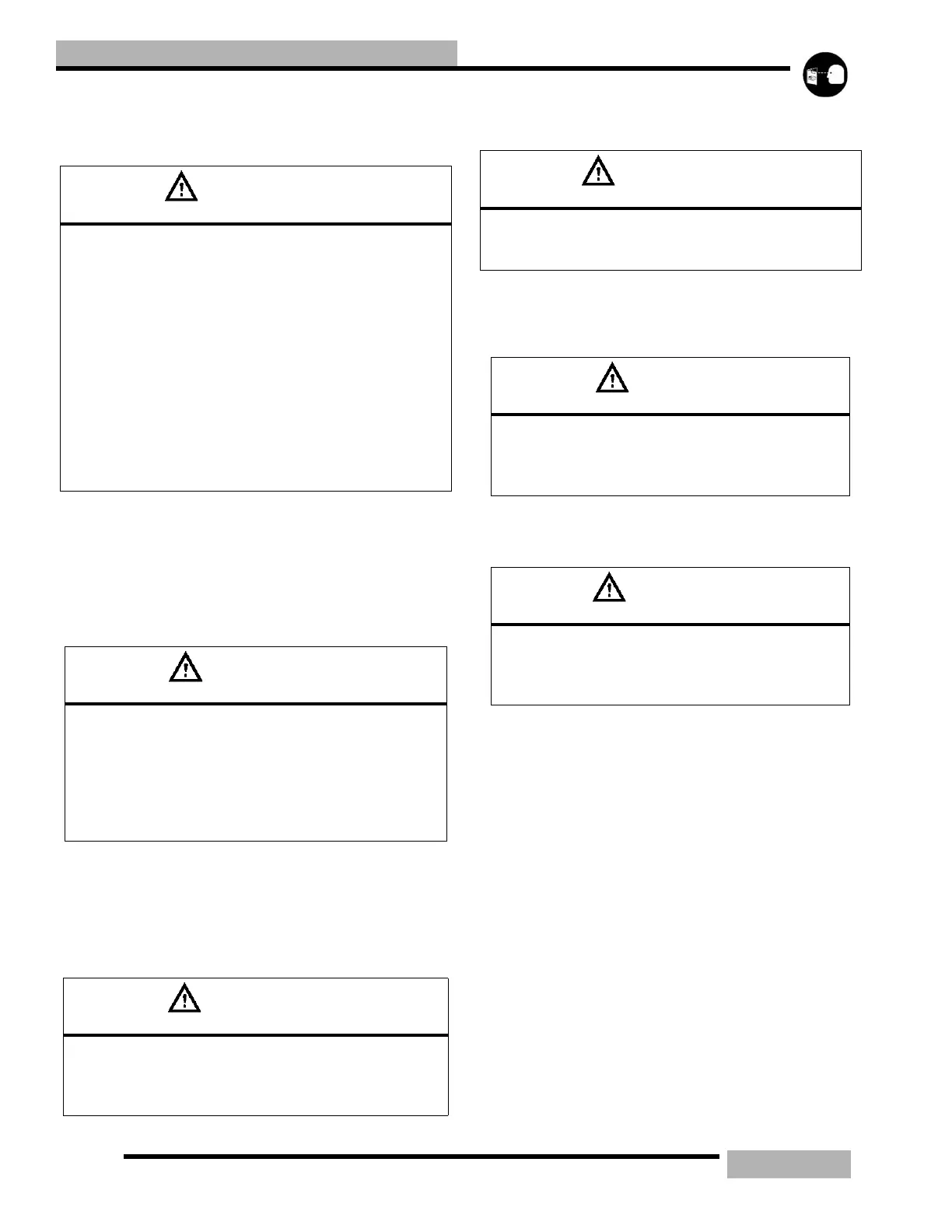